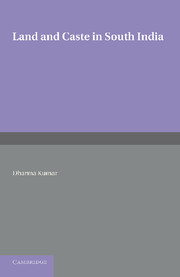 Land and Caste in South India
Land and Caste in South India Book contents
- Frontmatter
- Dedication
- CONTENTS
- List of Tables and Figures
- Acknowledgements and A Note on Certain Connventions
- Abbreviations
- Map of the Madras Presidency
- PART I
- I INTRODUCTION
- II THE AGRARIAN BACKGROUND
- III FORMS OF AGRESTIC SERVITUDE
- IV THE IMPORTANCE OF AGRICULTURAL LABOUR IN THE FIRST HALF OF THE NINETEENTH CENTURY
- V OFFICIAL POLICY AND THE EMANCIPATION OF THE AGRICULTURAL LABOURER
- VI OFFICIAL POLICY: LAND TENURES AND LAND REVENUE
- PART II
- Glossary
- Bibliography
- Index
IV - THE IMPORTANCE OF AGRICULTURAL LABOUR IN THE FIRST HALF OF THE NINETEENTH CENTURY
from PART I
Published online by Cambridge University Press: 05 June 2016
- Frontmatter
- Dedication
- CONTENTS
- List of Tables and Figures
- Acknowledgements and A Note on Certain Connventions
- Abbreviations
- Map of the Madras Presidency
- PART I
- I INTRODUCTION
- II THE AGRARIAN BACKGROUND
- III FORMS OF AGRESTIC SERVITUDE
- IV THE IMPORTANCE OF AGRICULTURAL LABOUR IN THE FIRST HALF OF THE NINETEENTH CENTURY
- V OFFICIAL POLICY AND THE EMANCIPATION OF THE AGRICULTURAL LABOURER
- VI OFFICIAL POLICY: LAND TENURES AND LAND REVENUE
- PART II
- Glossary
- Bibliography
- Index
Summary
In the light of this connection between caste and occupation it is possible from the censuses of 1871 and thereafter to estimate the numbers of agricultural labourers in the pre-census period. More precisely, such an estimate requires two assumptions. As we have seen, the agrarian ‘serfs’ and ‘slaves’ were drawn from a few castes such as the Cherumans, Pallans and Paraiyans, which may be termed the agricultural labour castes. The first assumption is that most members of these castes were in fact agricultural labourers, whether free or unfree. The second and less important assumption is that these castes did not grow at very different rates from the rest of the population. Thus, from the proportion of these castes to total population at the end of the century as given by the census returns, and from the figures of total population at the beginning of the century as given by contemporary estimates, one can derive the size of the agricultural labour castes and hence, on the first assumption, of the rough number of agricultural labourers at this date. There is the further possibility that agricultural labourers might have been drawn from other castes as well.
However, the argument is not sustained solely by this chain of inference ; the evidence of contemporary documents also supports the presumption that slavery was widespread in the early nineteenth century. Figures of the ‘slave’ population at this time are available for certain districts. These figures, which were supplied by the Collectors to the Board of Revenue, have to be used with caution, since the Collectors did not distinguish clearly between the traditional occupation of the caste and the actual occupation. Whether they are referring to caste or occupation can sometimes, but not always, be inferred from the context; it is likely that most figures of ‘slaves’ refer not to those who were actually agricultural or other ‘slaves’ or serfs, but to the Cherumans, Pallans, Holeyas, etc. But the fact that caste and occupation were so easily confused is significant in itself.
As one would expect, the fullest data are available for Malabar and Canara where agricultural servitude took its harshest form. Figures are available from as early as 1800-1, when Buchanan quotes the estimates given to him by the Collectors of Malabar and Canara.
- Type
- Chapter
- Information
- Land and Caste in South IndiaAgricultural Labour in the Madras Presidency during the Nineteenth Century, pp. 49 - 63Publisher: Cambridge University PressPrint publication year: 2013


